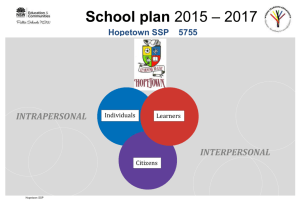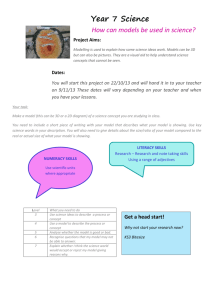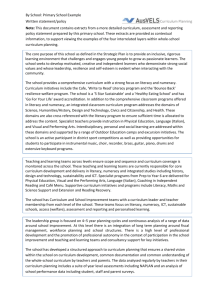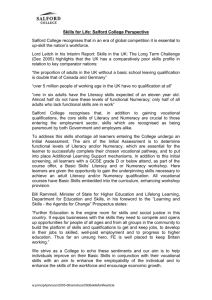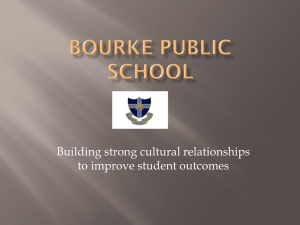Annual School Report 2014
advertisement
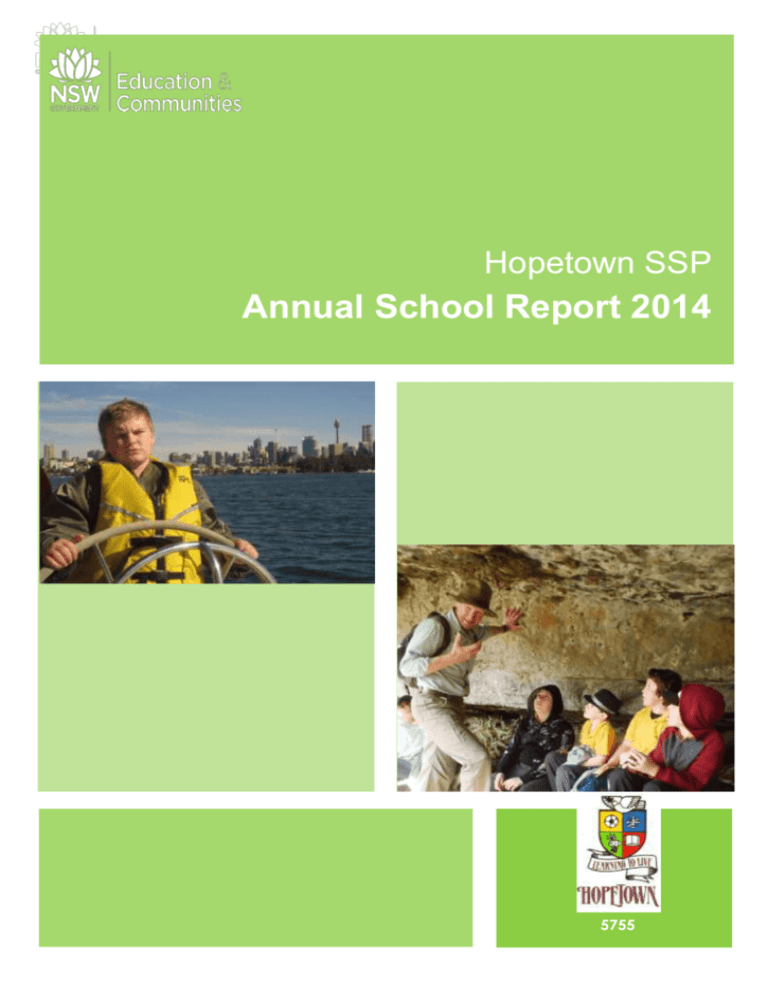
Hopetown SSP Annual School Report 2014 [school code] 5755 emotional literacy. Emotional literacy is actively promoted and comprises the domains of selfawareness, self-regulation, empathy, social skills and motivation. School Context Students Hopetown is a School for Specific Purposes (SSP) administered by the NSW Department of Education and Communities. Hopetown services the needs of primary and secondary students with emotional disturbance. Students residing on the Central Coast may be referred for enrolment. Hopetown endeavours to provide a therapeutic environment with a multi-disciplinary approach to special education and individual student needs. The school, where possible, emulates mainstream school policies and practices in an attempt to increase student self-esteem and expectations. Hopetown’s maximum possible enrolment in 2014 was 56 students. There were 3 primary and 5 secondary classes of 7 students in each class. Hopetown actively encourages parent/carer and community involvement in all aspects of curriculum and behavioural programming. Access to the many resources of the public education system has allowed staff and students to enjoy professional and productive support and development. Staff Hopetown had 20 staff in 2014. This was comprised of 10.2 teaching and 9.9 support staff. All teaching staff met the professional requirements for teaching in NSW public schools. I certify that the information in this report is the result of a rigorous school self-evaluation process and is a balanced and genuine account of the school’s achievements and areas for development. Significant programs and initiatives Being a School for Specific Purposes, Hopetown has specialist staff and a staffing ratio of 1 teacher plus 1 School Learning Support Officer for each class comprising 7 students. Terry Taylor - Principal Special programs and initiatives included: • Priority Schools Funding Program (PSFP) • Diagnostic Learning Centre • Social and Emotional Learning Program • Vocational Training Student information Hopetown enrolls primary and secondary students who have experienced or would encounter difficulties in mainstream school settings. Poor attendance in past schools has often been an indicator of these difficulties. The enrolment limit for 2014 was 56 students at any one time. Principal’s message The suitability of each student's placement was reviewed every term. Fifty-eight students attended Hopetown School in 2014. All were males and 11 students identified as being of Aboriginal descent. The positive culture at Hopetown SSP is a result, in part, of setting high expectations and then recognising, acknowledging, celebrating and promoting student and staff achievements. This report is part of that process and is a testament to the effectiveness, diversification and relevance of programs at Hopetown SSP. Hopetown works closely with the Central Coast School Education Area home school liaison team, the Assisted School Travel Unit, Juvenile Justice, Community Services, Area Health and other agencies to address some of the behavioural and logistical difficulties some students had with school attendance. Hopetown services the needs of primary and secondary students with emotional disturbance. The school is situated on an open rural setting and is well resourced with amenities including an indoor heated pool, playing fields, tennis courts and a multipurpose hall. The student population of 56 was based on an allocation of 8 classes of 7 students each. There could be 21 primary and 35 secondary students enrolled at Hopetown at any one time. The primary purpose of enrolment at Hopetown is the development of students’ social skills and 1 Where possible, the primary and secondary units are separated physically and operationally in consideration of student focus, optimal learning environments and safety. Senior students undertaking vocational or trade training Thirteen students were enrolled in Year 11 and 2 students in Year 12 during 2014. Seven of these senior students participated in TAFE courses (TVET) and in a range of work experience and work education programs. Flexibility is an essential aspect of Hopetown's programming in order to meet the varying needs of students and to respond to different rates of progress. Class groups are determined by ability and not according to grades. The other consideration for class composition is the mix of personality types, behavioural characteristics, developmental stages and degrees of resilience of the students. Year 12 students attaining HSC or equivalent Vocational educational qualification Four students completed Year 12. Workforce information A home-group model of class arrangement has been maintained in view of its past success. The secondary classes are similar to those in middleschooling and have been timetabled to minimise disruption, reduce anxiety, to provide consistency in curriculum delivery and teaching style and to enhance a sense of ownership and self-direction in a student's learning. Workforce composition Position Principal Assistant Principal(s) Classroom Teacher(s) Teacher Librarian School Counsellor School Administrative & Support Staff Total Student enrolment profile Number 1 3 6 0.2 0.5 9.9 20.6 Hopetown has always been proud of its student attendance record. Prior to enrolling at Hopetown, many students had histories of truancy, school avoidance, multiple suspensions, partial attendance or school-phobic behaviours. No staff at Hopetown SSP identified as Aboriginal or Torres Strait Islander Student attendance profile All teaching staff meet the professional requirements for teaching in NSW public schools. Teacher qualifications The average attendance rate for all students enrolled in 2014 was 89% (secondary students 86%, primary students 93%). The attendance rate for the previous year (2013) was 94.2%. Attendance for the first semester was 93% but it dropped to 85% in the second semester. As the year progressed, a number of older secondary students were at a significant risk of disengagement from learning and found it difficult to maintain regular attendance. Qualifications Degree or Diploma Postgraduate NSW Institute of Teachers Accreditation Management of non-attendance School non-attendance is managed initially by close and timely communication between the school and parents/carers. Negotiated partial attendance programs and a range of alternative experiential programs are used to increase the attendance and engagement of specific students. The Assisted School Travel Unit also supports families who have logistical difficulties in getting students to and from school. Assistance from Home School Liaison Officers is requested and given when required. 2 % of staff 100 40 20 Financial summary Achievements This summary covers funds for operating costs and does not involve expenditure areas such as permanent salaries, building and major maintenance. Sport Date of financial summary Income Balance brought forward Global funds Tied funds School & community sources Interest Trust receipts Canteen Total income Expenditure Teaching & learning Key learning areas Excursions Extracurricular dissections Library Training & development Tied funds Casual relief teachers Administration & office School-operated canteen Utilities Maintenance Trust accounts Capital programs Total expenditure Balance carried forward Hopetown is proud of the excellent student attendance and participation at its annual secondary swimming carnival. This was a credit to the students and a positive indicator of both school spirit and individual confidence. The primary students also participated enthusiastically in their own swimming carnival at Hopetown. 30/11/2014 $ 365,957.13 149,655.92 92,779.90 82,790.78 9,928.53 3,775.05 0.00 704,887.31 Students have benefited from the delivery of an Austswim program in Terms 1 and 4 with all participants showing an improvement in skills, technique and confidence. Our Safe Boating Program continued this year with participating students gaining a NSW Roads and Maritime Services boat licence. An incentive in the program was the opportunity for successful licence holders to operate the school boat on outings. 13,355.77 5,904.30 3,889.80 1,936.75 2,747.36 98,245.33 26,682.53 83,887.72 0.00 46,157.74 31,393.44 4,914.10 0.00 319,114.84 385,772.47 Hopetown’s surfing program continued with a pre-requisite surf survival course followed by instruction in surfing skills. Some student qualified for open-water snorkelling certificates. High ropes courses, abseiling, martial arts, freestyle and mountain biking, martial arts, snow skiing , ice-skating, surfing, snorkelling, rock-wall climbing, tabloid activities, sailing, whip cracking, juggling, stilt walking and uni-cycling have provided students with unusual, concrete experiences of how patience, perseverance, selfcontrol and sharing can produce satisfying results. A full copy of the school’s 2014 financial statement is tabled at the annual general meetings of the School Council and/or the parent body. Further details concerning the statement can be obtained by contacting the school. Students were also actively involved in programs which promote dynamic, healthy and responsible lifestyles. These programs included Live Life Well at School and Life Education School performance 2014 Academic achievements Excursions The diversity and relevance of activities conducted during 2014 have promoted student engagement, encouraging students to accept challenges and to contribute to the school and broader community. Student social and emotional learning (SEL) has been a focus in all activities. Many achievements have been the result of setting high expectations for students and the inclusion of mainstream activities in the school’s operations. 3 Henry Kendall Cottage Museum Sydney Royal Easter Show Sydney Writers Festival Kooindah sculpture exhibition ‘Macbeth’ performance – Sydney Opera House B Smart Road Trauma Forum Freedman Foundation School Sailing Program TAFE and University campus visits Community Involvement RYDA driver education CARES Road and Bike safety exercises Students were actively involved in community and charitable work including: Australian Reptile Park Clean Up Australia Day TOCAL Agriculture Field Day ANZAC Day ceremony Sailors with Disabilities Sail Day – Sydney Harbour Sunnies for Sight fundraising Bandana Day (children’s cancer research) Service Learning program; the Rural Fire Service and Volunteering Central Coast. Youth Eco Summit Workshop - Homebush Community Access and Travel training program Sculptures by the Sea - Bondi Central Coast Careers Market Try-a-Trade Skills Day Job Centre Careers Day Avondale Careers Market Newcastle University Big Day In National Maritime Museum Awabakal Nature Reserve Brisbane Water National Park Other achievements The Students' Café and Primary lunch program have been engaging ways to teach students specific work skills and to encourage consideration, trust and co-operation in both the student workers and customers. Improved nutrition and variety were the main considerations when students were set the task of compiling menus. Recent staffing reductions have unfortunately resulted in the cessation of the Students’ Café. Academic School Camps We are committed to the belief that all children can learn within a supportive environment. We implemented school-wide approaches to teaching and learning literacy and numeracy and expected that these approaches would significantly improve student literacy and numeracy outcomes. During the winter season, selected students enjoyed a week at Smiggin Holes receiving daily skiing lessons and experiencing communal living in a large chalet situated in the snowfields. This opportunity allowed students to return to school with an enrichment of experience, increased enjoyment of social interaction and a sense of personal achievement as a result of new challenges having been met. Both individual literacy programs and classroom programs are designed and delivered to encourage students to achieve improvements in their literacy and numeracy outcomes. Students have been given opportunities to access formal, national testing (NAPLAN) in literacy and numeracy for students in years 3,5,7 and 9. These results help the school to identify and program for further improvements in 2015. Water sports, bush craft and other outdoor activities were the focus of two camps held in Term Four at the Sandbar Camp, near Forster and also at a camp at The Basin, Pittwater. Skills in communal living, co-operation and tolerance were the focus. Selected Year 6 students enthusiastically participated in the secondary camp at Del Rio, Wiseman’s Ferry as part of their transition program. Many students need high-level interventions if they are to succeed as readers and writers, to be numerate or to succeed in school. Regular assessment has been integrated into school activities to determine student teaching and learning requirements. Participants in the Duke of Edinburgh Awards Scheme also had overnight camps at Webbs Creek. Students identified as ‘at risk’ of under-achieving now access a range of additional literacy and numeracy resources. There is continuity in the 4 development of each student’s literacy skills through a planned, whole-school approach and the teaching of literacy in an explicit and systematic way. The Norta Norta program has also provided funding for a tutor to support Aboriginal students who have been identified in NAPLAN testing as requiring assistance in improving their literacy and or numeracy skills. a class set of cameras enabling students to take photographs of items of personal interest as stimuli for writing survival reading exercises. The following resources, including computerbased literacy programs, have been utilised. Future Schools – personalised online assessments, tutorials and exercises accessible from school and home Fast Forward - multi-media reading programs Lexia Learning – Reading Strategies for Older Students (SOS) and Cross Trainer (Visual / Spatial, Logical reasoning suite). The Lexia Comprehensive Reading Test is used to identify a baseline for the SOS program pre-reading Hopetown’s school-wide assessment schedule has enabled staff to plan and consistently apply testing in literacy to ensure: diagnostic data collection identifying areas of student strength and areas requiring remediation or compensation, literacy gains are measured and evaluated in terms of the effectiveness of the programs offered at the school and targeting of specific staff professional development in literacy based on data collected. Literacy and The assessment schedule included the following testing and re-testing each semester: Neale Analysis of Reading Ability (3rd edition) Schonell Graded Word Reading Test Waddington Diagnostic Reading Tests Wide Range Achievement Test 4 (WRAT 4) Spinout Stories readings Nelson Focus Reading Storybook Weaver Waddington Spelling Test Teachers4Teachers reading boxes Aussie Spellforce – spelling tutor Copying tasks and placement tests for reading comprehension. Reading for Literacy - a fully interactive learning program designed to develop children's key reading skills – age appropriate Literacy assessment results for students enrolled at Hopetown Special School during 2014 were: ABC Reading Eggs – Literacy e-learning Studyladder – Smart-board e-learning Secondary results Reading Mastery – Phonics program Reading age equivalent specially designed units of work using subject matter of specific interest to individual students and sourced from newspapers, magazines, brochures, catalogues, libraries, manuals, audiovisual materials and reading in the community Year comparison 2013 2014 Unable to be tested 16 0 Maintained initial level 48 37 1 – 11 month gain 20 35 12 months+ gain 16 28 5 % of students Primary results Reading age equivalent Year comparison Primary results % of students Numeracy age equivalent %of students Year comparison 2013 2013 2014 Unable to be tested 5 0 Unable to be tested Maintained initial level 0 33 1 – 11 month gain 69 12 months+ gain 26 2014 11 0 Maintained initial level 6 40 26 1 – 11 month gain 44 15 41 12 months+ gain 39 45 Numeracy We expect to achieve improvements in numeracy results with all students able to access the following computer-based numeracy programs in classrooms: Numeracy is the ability to use mathematical ideas efficiently to make sense of the world. A high percentage of students commence enrolment at Hopetown with significant deficits in numeracy. Erratic attendance patterns in previous schools have often resulted in students having considerable gaps in concept development. Many students are reluctant or resistant learners who require significant structure, encouragement and support to develop their skills in numeracy. Students on a Life Skills program of study had Individual Education Plans to consolidate basic numeracy skills and focus on practical applications of those skills. Distance Education learning packages for secondary students accessing a regular pattern of study in mathematics have been both exciting and challenging. WRAT4 and Schonell Numeracy Screening Test assessment results showed students' progress in numeracy age levels as follows: Secondary results Numeracy age equivalent %of students Year comparison 2013 Unable to be tested 12 0 Maintained initial level 25 72 1 – 11 month gain 34 14 12 months+ gain 29 14 Future Schools – personal online assessments, tutorials and exercises accessible from school and home Mathletics – a stimulating program enabling student in different schools and countries to contest their numeracy skills in real-time competitions. Ultimate Aussie Maths Invaders: a curriculum based mathematics learning sequence which allows for students with special needs. Maths Made Easy - lessons contained in the program have been developed from the Mathematics curriculum Studyladder, Daisy Maths, Cool Maths, Maths Tracks and similar software Maths Plus - assessment tools and workbooks. Interactive whiteboards in most classrooms are proving to be engaging and motivating teaching and learning resources. 2014 Significant programs and initiatives Aboriginal Background Hopetown received specific funding to support Aboriginal students under the Resource Allocation Model (RAM). The funds enabled the implementation of the Aboriginal and Torres Strait Islander Education Action Plan 2010 -2014, 6 a Partnership Agreement between the Department of Education and Communities and the Aboriginal Education Consultative Group Incorporated (AECG). Units of studies in Aboriginal culture were taught in Term Three and culminated in Hopetown’s Aboriginal Cultural Fortnight. All Aboriginal students at Hopetown SSP have Personalised Learning Plans which have been negotiated with each student, their parents/carers and teaching staff. PLPs are an integral part of the students’ Individualised Education Plans. Norta Norta funding also provided a tutor to assist Aboriginal students identified in NAPLAN results to be requiring additional support. Hopetown is an active participant in the Wyong Aboriginal Education Consultative Group (Ngara AECG) with staff attending all meetings in 2014. Socio-economic background Hopetown’s enrolment includes students from low socio-economic backgrounds and equity funding support had been provided under the Department’s Resource Allocation Model. Programs in Key Learning Areas allowed students to explore and learn about Aboriginal history and culture. This Annual School Report attests to school initiatives and activities that have raised the expectations of students and their parents/carers and increased community involvement. Languages other than English (LOTE) – Aboriginal languages. Students were required to respond to words, phrases and simple sentences used in aboriginal languages. Students explored links between culture and a sense of identity specifically related to traditional connections and historical events linked to land and language. Connections between students/parents/carers and community organisations have been actively promoted. The organisations have included clinical support services, employment and vocational training agencies and career expostions. Music/drama/ visual arts – Aboriginal performance, film and television. The study of both traditional and contemporary Aboriginal artists in a range of media (theatre, music, visual art) allowed students to gain an understanding of the link between culture and history Hopetown’s inclusive school culture is actively sustained. It is essential for all our students to feel: Aboriginal cultural excursions included the National Maritime Museum NAIDOC exhibition, Awabakal Nature Reserve, Swansea, Jake Cassar’s ‘Back on Track’ Aboriginal culture and bushcraft program and the Brisbane Waters National Park rock engravings excursion with Rumbalara. The school’s bush tucker garden was renovated and further developed as part of the school’s work experience program. Human Society and Its Environment (HSIE) focused on the identity of Australia as a nation. This involved an examination of the process of government and law including Aboriginal law and its relevance to past and present Australian society. they belong in the school they are valued they will experience success at school their successes will be acknowledged and celebrated. RAM equity funding has enabled student access to a wide range of curriculum learning experiences, for example the appointment of a music teacher / therapist for one day each week. The funding also provided for experiential learning opportunities as listed elsewhere in this report. In turn these have resulted in increased student participation and engagement in learning and improved student learning outcomes. Multicultural education Programs in the following Key Learning Areas allowed students to explore and learn about multicultural issues. 7 Languages Other Than English (LOTE) – Anti-Racism, Cultural Diversity. Through the study of languages from other cultures, students made linguistic connections between diverse groups of people in Australian society and the languages they use. Languages studied included Italian, Japanese and Aboriginal dialects. Studies included cultural issues such as diversity in culture, religion and lifestyle in Australian society. Concepts and contemporary examples of racism, anti-racism and discrimination were explored in this unit. Human Society and Its Environment – Citizenship and Society. Anti-racism, discrimination and Australia’s multicultural society were explored when studying the development of Australia as a nation and issues of immigration in Australia’s past and present. Work Education studies included a unit on ‘discrimination’. Food Technology programs guided students in the exploration and celebration of cultural and culinary diversity. Hopetown’s Social and Emotional Learning program which is delivered across the curriculum and also in discrete timetabled lessons as mentioned above. explicit teaching of Hopetown’s three expectations, namely; Be Safe, Be Respectful, Be Responsible, a revision of Hopetown’s Anti-Bullying Plan and Policy community involvement projects as listed earlier in this report, Work Education looking at vocational rights and responsibilities , A specific unit on Bullying being studied by some secondary students in Term 2 promoting the Getting Along component of the You Can Do It! program. School planning and evaluation 2012—2014 School planning 2012-2014: School priority 1 Personal Development, Health and Physical Education (PDHPE) lessons included a focus on issues of intolerance and discrimination. Improved student engagement and retention. Outcomes for 2014 Social and Emotional Learning (SEL) is timetabled and taught in every class. They are based on Emotional Literacy domains of self- awareness, selfregulation, empathy, social skills and motivation. Values, multiculturalism and anti-racism were integrated in discrete units Social and Emotional Literacy. Activities included students examining themselves, their values and beliefs and the impact they have on those around them. Students were provided skills to create an awareness of multicultural issues. Evidence-based and student-focused Social and Emotional (SEL) programs will be accessed by all students. Each student will have a negotiated transition pathway supported by a relevant and engaging range of programs. Staff Professional Learning Plans will be responsive to both student and staff needs and will seek best practice in meeting such needs. 2014 Targets included: A student attendance rate of at least 93% for secondary and 97% for primary students. Respect and responsibility Core values of respect and responsibility were promoted by: An average of no more than 410 negative student welfare referrals per term. 80% of post-compulsory aged students would be retained in school or have 8 transitioned to employment, vocational training or a community access program. 80% of primary and 70% of secondary students will have been assessed as making gains in at least 3 of the 5 domains of Emotional Literacy (Southampton Assessment). School priority 2 Strategies to achieve these targets included: Improved literacy and numeracy outcomes for all students. The introduction of a Mindfulness program designed to improve student attention, concentration, self-awareness and emotional balance. This was a pilot involving 1 to 1 guidance with selected students. Outcomes for 2014 A comprehensive battery of assessment tools will meaningfully inform and help evaluate literacy and numeracy programs. The review and evaluation of alternative programs designed for students at risk of disengagement from learning at school. This was a continuation of an existing program. Student engagement in literacy and numeracy skill development will be enhanced by the use of ICT. Instruction in literacy and numeracy will be programmed as integral components across the curriculum. The encouragement of student participation in service learning and a continuation of the Duke of Edinburgh Scheme. 2014 Targets and actual results: Secondary results Staff professional learning in Attachment Disorders and best practice in schools for meeting the needs of students with such diagnoses. Reading age equivalent Staff professional learning continuing to focus on student welfare, mental health, Quality Teaching (particularly the dimensions of Significance and Environment) and ICT. Year comparison Unable to be tested Evidence of achievement of targets in 2014: 65% of primary and 58% of secondary students were assessed as making gains in at least 3 of the 5 domains of Emotional Literacy (Southampton Assessment). The target was not met. % of students Target Actual 0 0 Maintained initial level 40 37 1 – 11 month gain 20 35 12 months+ gain 40 38 Primary results The average attendance rate for all students enrolled in 2014 was 89% (secondary students 86%, primary students 93%). The target was not met. Reading age equivalent Unable to be tested 0 0 The term average of negative welfare referrals in 2014 was 513 referrals per term. This did not meet the target of 410 however the Term Four total was only 363 referrals. Maintained initial level 5 33 1 – 11 month gain 70 26 12 months+ gain 25 41 Year comparison Exactly 80% of post-compulsory aged students were retained in school and transitioned to employment, vocational training or a community access program. This met the school’s target. % of students Target Actual Secondary results Numeracy age equivalent %of students Year comparison Target Actual Unable to be tested 9 5 0 Maintained initial level 25 72 1 – 11 month gain 40 14 12 months+ gain 30 14 Primary results Numeracy age equivalent %of students Year comparison Target Actual Surf Lifesaving Medallion Child Protection Australian Association Education Conference Nurturing Attachments seminar ‘Distressed seminar or Association Bronze of Special Deliberately Defiant?’ Unable to be tested 0 0 Maintained initial level 5 40 Mindfulness and Self-Regulation seminar 1 – 11 month gain 45 15 12 months+ gain 50 45 ‘Towards a More Altruistic Society’ workshop PE Network meetings Royal Lifesaving Resuscitation COURSERA Sport and Society Special Education Technology Needs Conference Marine Teachers Annual Conference School Link Conference (Mental Health) AUSTSWIM Teacher of Swimming and Water Safety NSW Maritime Certificate NSW Maritime Licence Credentialing course WHS representative training C.R.E.A.T.E. IT workshop (electronics, art and technology) Cheese making workshop Learning and Engagement Head Teacher Network meetings Using Adobe in any Classroom Senior First Aid Positive Behaviour Management Talk for Writing (SPELD) Aspiring to Leadership Strategies to achieve these targets included: Assessing 100% of students using a range of diagnostic and summative literacy and numeracy assessment tools (NAPLANbased targets are problematic because of poor and erratic student participation and the low statistical base for each cohort.). Staff use of data from the Wide Range Achievement Test (WRAT-4) assessment tool to better diagnose and determine individual student abilities and needs. An expansion of the incorporation of accommodations and adjustments in student IEPs and their implementation. An increase in the supply and use of laptops and software in the primary unit. The use of cameras to provide students photographic stimulus material for literacy tasks. Professional learning Professional learning in 2014 concentrated on the areas of Welfare and Equity, Career Development and Quality Teaching. 100% of teachers and support staff participated in a range of professional development opportunities including: Cardio Radio Pulmonary Operators Nonviolent Crisis Intervention Primary Executive Leadership Conference Australian Curriculum Equipment Safety in Schools Attachment Disorder in Schools Chemical Safety in Schools Student Support using Mindfulness Anaphylaxis E training 10 Bushfire E learning DEC WHS E Induction DEC Child Awareness MAYBO Assault disengagement %A %U I feel Hopetown is the appropriate school for my child at this stage. 71 16 Hopetown ensures that everyone at the school is treated fairly. 84 13 I feel that my opinions are listened to and valued. 74 19 Teachers provide activities that are interesting and appropriate to a student’s individual needs and learning abilities. 84 16 The way teachers manage the class helps my child to learn 74 16 Hopetown provides clear information about student achievement. 84 16 I believe that Hopetown has a positive school culture 74 23 I feel that Hopetown staff accept and support my child. 80 20 Parent/carer responses are presented in the following table. Hopetown encourages students to achieve their best. 87 13 Responses parents/carers were asked to choose from for each question were: ‘Always’ (A), ‘Usually’ (U), ‘Sometimes’, ‘Rarely’. It is encouraging that no respondents indicated ‘Never’ in the 2014 survey. Numbers in the table indicate the percentage of respondents. Student achievements are recognised and rewarded at Hopetown. 97 3 Hopetown’s discipline of students is fair. 84 13 I think Hopetown communicates effectively with parents/carers 80 10 Hopetown communicates effectively with students. 90 3 My child’s classroom is an interesting place in which to learn. 77 16 Hopetown’s staff understand my child’s social and emotional needs. 80 13 Hopetown provides a variety of activities to improve my child’s engagement in school and learning. 87 10 Hopetown is always looking for ways to improve what it does. 84 16 reduction MAYBO Train the trainer Disability Standards for Education and Parent/caregiver, student, and teacher satisfaction Parents and carers have been able to enjoy regular reciprocal communication with the school, to participate in decision making and to discuss reports and assessments related to respective students. In 2014 the school sought the opinions of parents/carers, students and teachers about the school. This parent / carer survey was conducted in Term Four of 2014. The questions were based on School Map questions about learning, teaching and culture. Apart from the survey above, other opportunities for parent and carer involvement in 2014 included the following. 11 Personal and active participation in Individual Transition Planning (ITP) meetings. In 2014, 86% of Hopetown’s secondary students had parent/carer representation at their ITP meetings. Parents/carers of ATSI students being consulted about and signing off on Personalised Learning Plans Daily or weekly communication books, emails, text or telephone calls home by the homeroom teachers, The purposes for each of these directions are: Parent/carer participation in student emotional literacy surveys (Emotional Literacy – Assessment and Intervention, Southampton Psychology Service, 2003; primary and secondary editions). To nurture students as motivated individuals valuing self and demonstrating self-efficacy, resilience and internal control. To develop a dynamic learning environment that empowers individuals to be flexible, adaptive, discerning learners and leaders. To encourage awareness of the individual as part of a wider society and create a culture of reciprocal and active concern for the wellbeing of others. The new plan is published on the school’s website. www.hopetown-s.schools.nsw.edu.au Parent/carer attendance at Presentation Day and sporting events, during which parent/carers interact with and provide feedback to staff About this report In preparing this report, the self-evaluation committee has gathered information from evaluations conducted during the year and analysed other information about the school's practices and student learning outcomes. The self-evaluation committee and school planning committee have determined targets for the school's future development. Parent/carer consultation with school administrators and staff regarding assistance with counselling, visits to clinicians, external support agencies, student special transport, reintegration to mainstream schooling, vocational training and transition. Future Directions 2015-2017 School Plan NSW DEC is implementing a new school planning process for 2015-17. Terry Taylor Principal Sue Donoghue Assistant Principal Donna Lott Assistant Principal Vince Malone Assistant Principal Melanie Todd Parents’ Representative The vision statement of Hopetown’s plan states: School contact information The collective purpose of the Hopetown School community is to ensure that every student becomes a successful learner, a confident and creative individual and an active, informed citizen. Hopetown SSP 177 Pollock Ave, WYONG 2259 The School Plan’s three directions for 2015 – 2017 are: School Code: 5755 Mail: P.O. Box 805, WYONG 2259 Phone: 43532522 Fax: 43512381 Email: hopetown-s.school@det.nsw.edu.au Website: www.hopetown-s.schools.nsw.edu.au Empathic, individuals. Students and staff are leaders of their learning. Parents can find more information about Annual School Reports, how to interpret information in the report and have the opportunity to provide feedback about the report at: A community of socially responsible citizens. http://www.schools.nsw.edu.au/learning/emsad/ asr/index.php resilient, motivated 12

